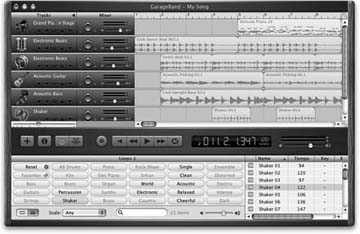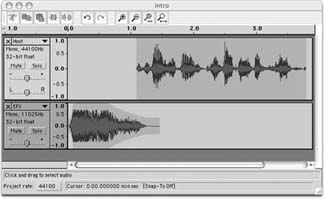Hack63.Add Top, Bottom, and Bumper Music
Hack 63. Add Top, Bottom, and Bumper Music
Cut and use tops, bottoms, and bumpers to give your podcasts a professional feel. You can use copyrighted material [Hack #68] from your favorite band to add music to your podcast, but the licensing issues can cost you time, money, and frustration. With today's music tools, you can create the top, bottom, and bumper music for your podcast very easily, and own the rights to the material. Tops, bottoms, bumpers, and stingers are music segments placed at the beginning, ending, and middle of your show. In the commercial radio world, bumpers bring you in and out of commercials. Stingers sit in between segments in a news show to delineate between stories. Whether these short music segments have vocals is up to you. For a mellower, more thoughtful show, you might go with only acoustic material and for a music show with a hard edge you might pick up something with vocals for the top and bottom. Generally the bumpers and stingers, because they are shorter, will not contain vocals. From a music standpoint, you want something that makes its presence felt and presents its theme in about four bars. If you are going to use a song, you should look at the beginning segments of a song for the tops, and the ends of songs for the bumpers. In any case, you should prefade the start and end portions of these segments to ease the transition from spoken word to music. 9.4.1. Building Your Own MusicApple's GarageBand and Sony's ACID [Hack #50] make it very easy to construct songs that sound good simply by dragging and dropping loops. Loops are portions of sound that repeat. They are categorized by instrument, genre, and beats per minute, and can contain raw sounds or repeating phrases of notes. Figure 9-5 is an example of something I threw together very quickly in GarageBand. To create your own song, start up GarageBand and then select New from the File menu to create a new song. Use the Show Loop Browser in the Control menu to show the loops you have available. To preview a loop, click the sound icon next to the name. To add it to your song, simply drag and drop it onto the track surface and position it wherever you like. Figure 9-5. The loop window in GarageBand 2 Use the mouse to click the righthand side of the loop to extend it for as many bars as you like. Then use the volume controls on the track to set the volume for that instrument. For loops where the content comprises notes, such as the one at the top of the example song shown in Figure 9-5, you can set the instrument by double-clicking the icon of the instrument. This is a fun and very addictive activity. You can create good soundI swear itsimply by dragging and dropping, even if you have no musical background. GarageBand comes with a wide variety of loops preinstalled. You also can buy packages of loops from Apple to supplement the loops in GarageBand, and you can find free sets of loops on the Web. To install new loops, simply drag the folder containing the loop files onto the loop browser from the Finder. Once you have your song, use the Export to iTunes command in the File menu to save the file in AIF format to your iTunes. At the time of this writing, Audacity had issues reading AIF files directly, so I had to use QuickTime to export the file as a .wav file that Audacity could read before bringing it into my podcast. If you want to find free music that you can get off the shelf without creating your own, check GarageBand.com (http://garageband.com/). Many of the songs on the GarageBand site are licensed under Creative Commons [Hack #68]. Although that is not a guarantee that you can use the song in your podcast, it's a good sign that you can. In particular, you should ensure that the license grants you the right to create derivative works. If you are a commercial entity, or are using this material for profit, you should check to make sure the license allows for commercial use. 9.4.2. Incorporating EffectsIf you're looking for a particular sound effect, such as the roar of a lion or the thrum of a motorcycle engine, you can usually find these on the Web. I've had good luck finding decent free sound effects at Partners in Rhyme (http://partnersinrhyme.com/). This company offers a wide selection of sounds and royalty-free music. In Figure 9-6, I took some boring intro vocal work and snazzed it up with an effect in another track. To do this, I used the Import Audio command to bring in the .wav file I downloaded from http://partnersinrhyme.com/. Then I used the Envelope tool to fade in the beginning a little bit, and to do a smooth fade out toward the end. Figure 9-6. Adding an intro sound in a different track in Audacity I recommend two additional sites for sound. Sounddogs.com (http://sounddogs.com/) has a wide variety of effects sounds, all of which are relatively inexpensive. MovieWavs (http://moviewavs.com/) contains sound samples from popular movies that vary in sound quality from very good to barely passable. Many have a high-frequency hiss that's caused by poor sample; using a low-pass filter, you can remove the hiss easily and create a sound that is fine as background material. If you can't find the sample you want from a movie, just use Audio Hijack Pro on your Macintosh or Total Recorder Pro on Windows to grab the audio directly from the DVD playback application. FindSounds (http://findsounds.com/), AltaVista Audio (http://altavista.com/audio/), WavSite (http://wavsite.com/), Analogue Samples (http://analoguesamples.com/), and Lost & Found Sound (http://npr.org/programs/lnfsound/) have sounds that you can download and play with, though you will have to account for permissions. As always, with copyrighted material you should be aware of copyright infringement issues [Hack #67]. 9.4.3. Making Your Own Sound EffectsAll you need to create your own sound effects are a portable recorder, a microphone, and some creativity. David Filskov maintains a list of sound effects recipes on his site (http://sfx.davelab.com/). Here is a sampling:
As you can see, you often can get something that sounds genuine from something other than the actual activity. 9.4.4. See Also
|
EAN: 2147483647
Pages: 144